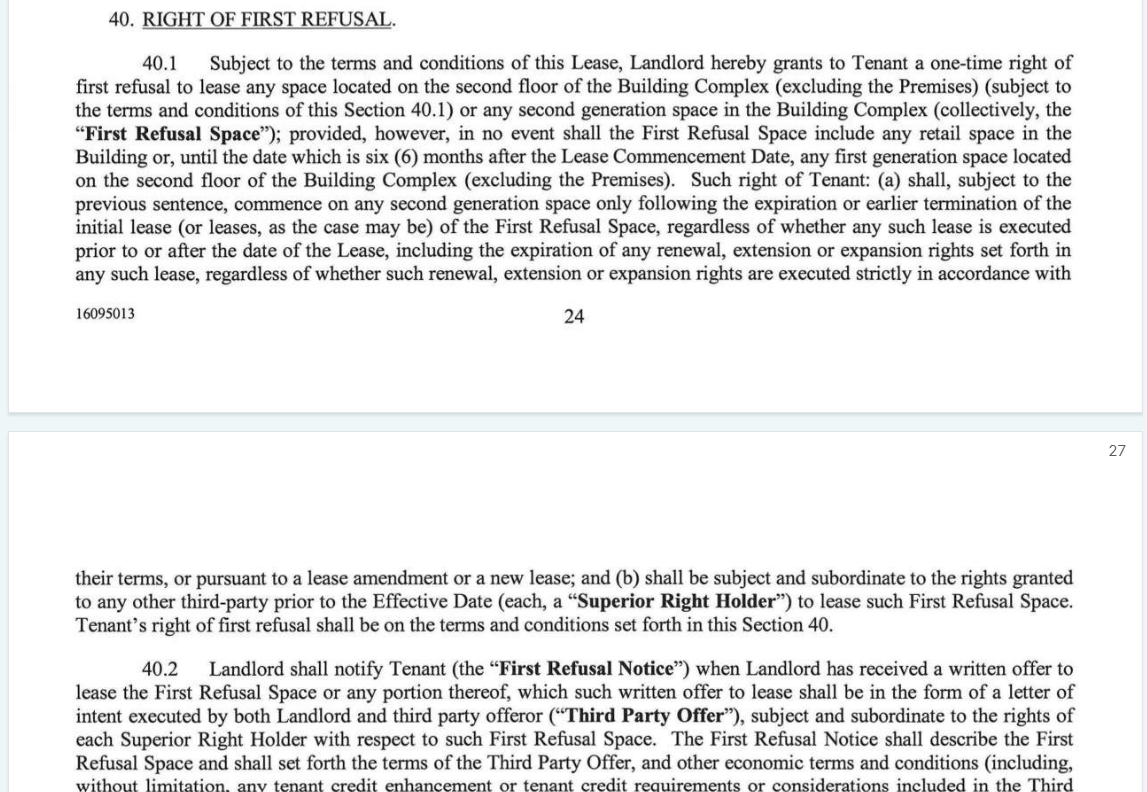Nine Types of Encumbrances We See in Commercial Leases (And Why They’re Important)
In addition to the AI and machine learning model that makes Prophia's lease abstracting capabilities so powerful, the platform also offers robust encumbrance tracking. Discover some of the common, albeit complex, terms we habitually encounter in commercial leases.

Leases are an incredibly important source of information for tenants, landlords, asset managers, brokers—essentially any individual who interacts with a commercial real estate transaction. These complex legal documents do more than specify when rent is due each month. They dictate the rights and responsibilities of both the landlord and tenant with complex legalese—or encumbrances—to ensure the property is used in a manner that is consistent with the terms of the lease.
There are many different types of encumbrances, some of which are specifically built to protect the interests of the landlord, others offer protection to tenants. They serve an important purpose, acting as the laundry list of conditions that make it possible for tenants to occupy a space and landlords to effectively manage their property. But, and this may come as no surprise, encumbrances can bring up a lot of questions throughout the negotiation process.
In this article, we will explore some of the most common examples of encumbrances found in commercial real estate leases and how they can be addressed.
Jump To A Section in This Article
What Is a Real Estate Encumbrance?
Tracking Lease Encumbrances
Nine Common Lease Encumbrances Found in CRE
What Is an Encumbrance in a Real Estate Lease?
As we mentioned, encumbrances refer to essentially any right the tenant has against the property. Often, these provisions relate to finance, but they don’t always. Examples of different encumbrances include easements, use restrictions, liens, rights of first refusal, purchase offer, etc. and are typically outlined in lease agreements to help govern the landlord-tenant relationship and protect the landlord's goals and objectives.

Tracking Lease Encumbrances
Whether an encumbrance is a financial stipulation or not, they play an incredibly important role in overall investing strategy. But if lease data is siloed or stored in unstructured, disparate formats across the portfolio, data access can become an impenetrable barrier for CRE teams, causing important data to be left on the table when it comes time to negotiate with existing or new tenants. And this is where Prophia can make a staggering difference.
With a sophisticated AI and machine learning model, Prophia captures the complex rights and terms contained within a commercial lease all in a single, digital platform. These capabilities also extend to encumbrance tracking, which allows asset managers to quickly access tenant encumbrances via Prophia’s lease summary or in a custom encumbrance report.
Better encumbrance tracking is a small but real step CRE teams can take to enhance operations, produce greater returns for investors, and provide clients with transparency.
Nine Common Encumbrances Found in CRE Leases
Rights of first refusal (ROFR)
A right of first refusal (ROFR) is a clause in a lease that gives the tenant the right to purchase the property before it is offered to anyone else. This type of encumbrance is common in situations where the tenant has invested a significant amount of time and money in improving the property and wants to ensure that they have the opportunity to purchase it if the landlord decides to sell.
When including a right of first refusal in a lease, it is important to specify the terms and conditions under which the tenant can exercise their right to purchase the property. For example, the lease might require the tenant to match any offer that is received from a third party or require the tenant to purchase the property at a certain price.
Rights of first offer (ROFO)
A right of first offer (ROFO) is a contractual provision that grants a party the opportunity to purchase a particular asset before it is made available to others. This provision is commonly used in business transactions and partnerships to protect the interests of the parties involved.
A ROFO provides the holder with the first opportunity to make an offer on an asset that is being sold. This means that the owner of the asset must first offer it to the ROFO holder before offering it to any other party. If the ROFO holder declines the offer, the owner is free to offer it to other potential buyers.
In order for a ROFO to be effective, the terms and conditions of the provision must be clearly outlined in the agreement and it must specify the asset that is subject to the ROFO, the price, and the time period during which the ROFO holder can exercise their right to make an offer. It may also include provisions such as the requirement for the ROFO holder to match any competing offers or the obligation to purchase the asset at a certain price. By including these terms, the parties can avoid confusion and disputes in the event that the ROFO is exercised.
Exclusive use
An exclusive use right is a provision in a commercial lease that grants a tenant the exclusive right to use a specific portion of the property for a particular purpose. This type of provision is common in retail and office leases where tenants may need exclusive use of certain areas or spaces to conduct their business operations effectively.
The exclusive use right ensures that the tenant has the exclusive right to use the designated space and that the landlord cannot lease the space to another tenant for a competing use. This type of provision helps to protect the tenant's business interests and can provide a competitive advantage in a crowded market.
When including an exclusive use right in a lease, it is important to clearly define the designated space and the permitted use. The lease should specify the terms and conditions under which the exclusive use right can be exercised and any limitations or restrictions on the use of the space. For example, the lease might require the tenant to use the space for a particular business purpose or prohibit the tenant from subletting or assigning the exclusive use right to another party without the landlord's prior consent.
Prohibited use
A prohibited use right is a lease clause that prohibits a commercial tenant from using the property for certain activities that may harm the property, other tenants, or the landlord's interests. These activities can include hazardous materials storage, illegal activities, or excessive noise or disruption. The lease should clearly define the prohibited activities and consequences of violating the provision to prevent a potential dispute.
Permitted use
Conversely to prohibited use, a permitted use clause outlines the specific purposes for which the tenant is allowed to use the leased property. This provision sets out the terms and conditions under which the tenant is permitted to use the property, ensuring that the tenant's activities are in compliance with the landlord's interests and any relevant laws and regulations.
Permitted use clauses can be broad or narrow, depending on the circumstances of the lease. For example, a permitted use clause in a retail lease might allow the tenant to use the property for retail sales and related activities, while a permitted use clause in an office lease might allow the tenant to use the property for general office use.
The terms of this encumbrance should also specify the consequences of violating any stipulations of the permitted use. By including these terms, the parties can avoid confusion and disputes over the permitted uses of the property and ensure that the tenant's activities are in compliance with all applicable laws and regulations.
Radius
A radius provision restricts a tenant from operating a similar business within a certain distance from the leased property. This type of encumbrance is often used in retail and office leases to protect the landlord's interests and prevent competition from nearby businesses.
The radius clause specifies the distance that the tenant is prohibited from operating a similar business and the consequences of violating the provision, such as the landlord's right to terminate the lease or seek other remedies. The clause typically also includes exceptions, such as allowing the tenant to operate a similar business in a different location or with the landlord's prior consent.
By including a radius clause in a lease, the landlord can limit competition and protect the value of the leased property. However, tenants should carefully consider the terms of the radius clause before signing the lease to ensure that it does not unduly restrict their ability to operate their business or expand in the future.
Subletting rights
Subletting provisions limit the ability of the tenant to sublease the property to another tenant. These provisions are typically included to ensure that the landlord has control over who is using the property and to prevent the tenant from subletting the property to a competitor or other undesirable tenant.
Subletting rights are particularly important for those with commercial property because it can allow them to keep a lease financially viable if a business should unexpectedly close or fail. Tenants should understand the parameters of their specific lease’s subletting restrictions and what is required for getting approval to sublet their space.
Subletting encumbrances are becoming increasingly important, particularly in metropolitan areas that are struggling to improve office vacancy rates. Due to this lagging occupancy, the US office market today holds a record 242.7 million square feet sublease space and these flexible leasing options could be a stabilizing force as the office sector continues to recover.
No build area
A no-build area encumbrance is a provision in a commercial lease that restricts the tenant or landlord from building on or developing a specific area of the property. This type of encumbrance is often used to protect the property or preserve its value by prohibiting construction or development that could adversely affect the property's use or value.
No build area encumbrances can apply to different areas of the property, such as setback areas, easements, or buffer zones. These provisions can also specify the duration of the encumbrance, which can be temporary or permanent, and may include exceptions or limitations for certain types of construction or development.
Purchase offer
Purchase offer rights grant a tenant the opportunity to purchase the leased property before it is sold to another party. This right is often sought by tenants who have a vested interest in the property and wish to secure its ownership for themselves.
Encumbrances like purchase offer rights in real estate ensure that the tenant has the first option to purchase the property, and that the landlord must first offer the property to the tenant before accepting offers from other potential buyers. It can be a valuable asset to the tenant, as it allows them to control the property's future use and provides stability for their business operations.
Navigating the complex world of commercial real estate leases can be daunting for landlords, tenants, and leasing professionals alike. But the reality is, encumbrances and rights are important keys to business intelligence as well as an investment strategy. To find out how Prophia can transform your firm’s portfolio data, reach out to a customer advocate and take a step closer to enhancing your encumbrance tracking and, by extension, insight that spans your entire commercial portfolio.
Hannah Overhiser
Hannah is Prophia's Content Marketing Manager and a seasoned B2B and B2C marketer. Her career began in eCommerce consulting with a focus on code testing. This technical expertise transferred seamlessly to SEO and she started working agency-side as an SEO and Content Strategist. Today, her home is Prophia, and she puts...

